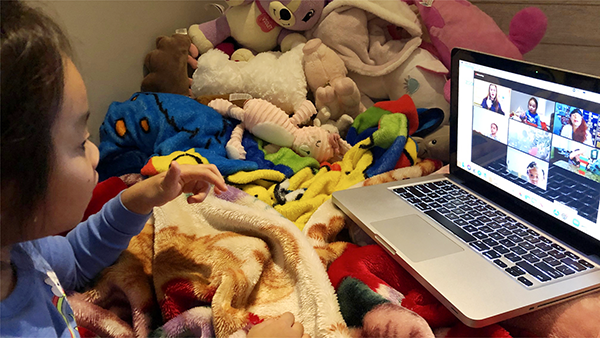Episode 3: Reflections on Inclusion in Remote Preschool
Early childhood special educators Brittany Behenna Griffith and Tara Hughes share strategies they use to include all children in their virtual classrooms. (11 min.)
Facilitator Guide
- Early Care and Education Environment Indicators and Elements of High-Quality Inclusion: E6: Instruction, E7: Collaborative Teaming
- DEC Recommended Practices: Instruction, Teaming and Collaboration
As you watch this episode, take note of the differentiated instruction strategies, including the use of visuals and materials, that Brittany and Tara implement. Also take note of how they got through the struggles of remote learning through collaborative teaming.
Reflection Questions
- Brittany Behenna Griffith emphasizes the importance of regular communication with related service providers to discuss progress and support provided for individual children as well as receive the support she needs from related service providers as she provides instruction. How have you experienced (or observed) collaboration with related service providers focused on building the educator's capacity and confidence with providing scaffolding, accommodations, and differentiated support to respond to children's needs? How does this type of collaboration lead to better outcomes for children?
- Think of a successful collaborative teaming moment you had with another professional. How did the collaboration create a better experience or outcome? What opportunities do you have in your current work to initiate more collaborative teaming that could lead to better experiences and outcomes?
- Write down five positive words that describe effective collaborative teaming? Now, give examples of how you plan to demonstrate each of the five words in your upcoming teaming efforts with professionals or families.
- Tara and Brittany discussed the importance of focusing on strengths and providing opportunities for children to show what they know in different ways. What strategies have you used to gain information on the individual strengths of children in your classroom? How have you intentionally provided opportunities for children to show what they know in different ways?
- Tara and Brittany also discussed examples for offering children different ways to make choices and answer questions that don't require a verbal response. What other ideas or strategies do you have for providing different options for children to use to respond during group and individual instruction and interaction?
Group Activity
Early childhood special educators Brittany Behenna Griffith and Tara Hughes reflected on the fact that inclusive classrooms have a strong focus on supporting children with peer relationships. How can a virtual environment be adapted when remote learning relies so heavily on verbal communication? Understanding that kids don't feel included if they can't participate, Tara and Brittany shared innovative strategies for engaging children by using visuals and allowing children to use different ways of answering questions, such as pointing to the screen or drawing a picture.
In groups of two, explore what it feels like to interact with a peer in a remote environment without verbal communication. Spend 5-10 minutes interacting non-verbally, (without written notes!) and then discuss how that experience felt.
- What did your partner do to communicate that worked well?
- Which nonverbal communication strategies did not work so well?
- What was your partner able to understand from your efforts to communicate?
- What was frustrating because they were unable to understand?
- Together with your partner, identify 3 practices that might be helpful when supporting nonverbal preschool-aged children to be able to interact with their peers.
Share and discuss with the large group.
Additional Resources
Practice Improvement Tools
- Instruction Practice Guides for Practitioners (see Following the Child's Lead, Naturalistic Instruction Practices)
- Teaming and Collaboration Practice Guides for Practitioners

